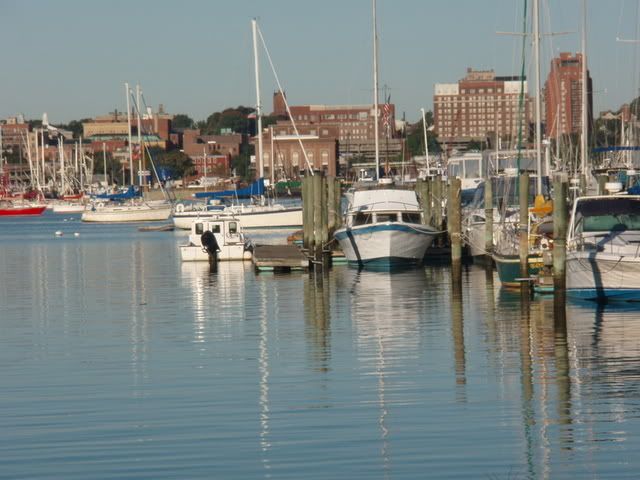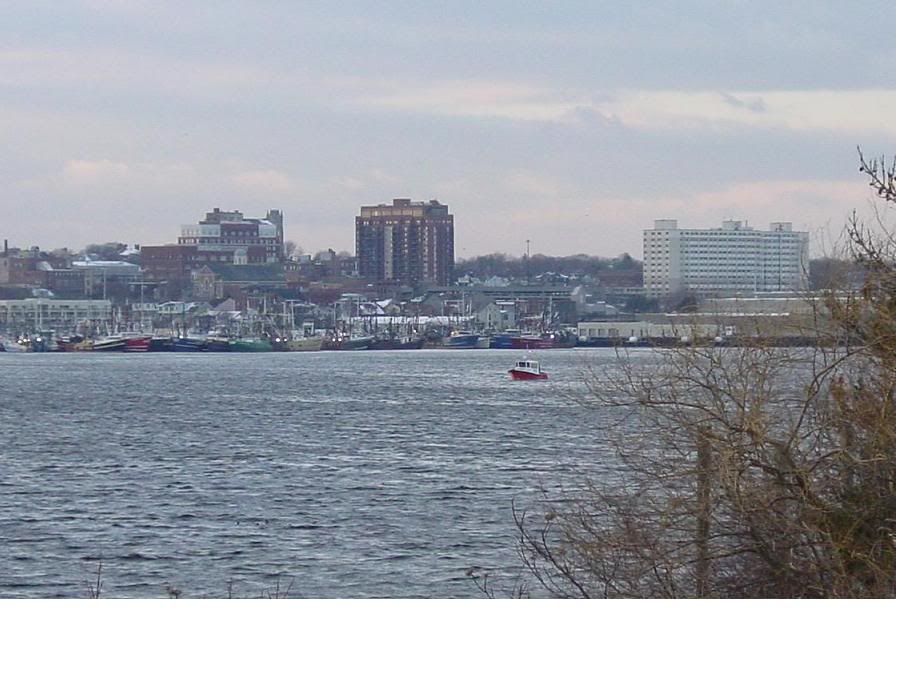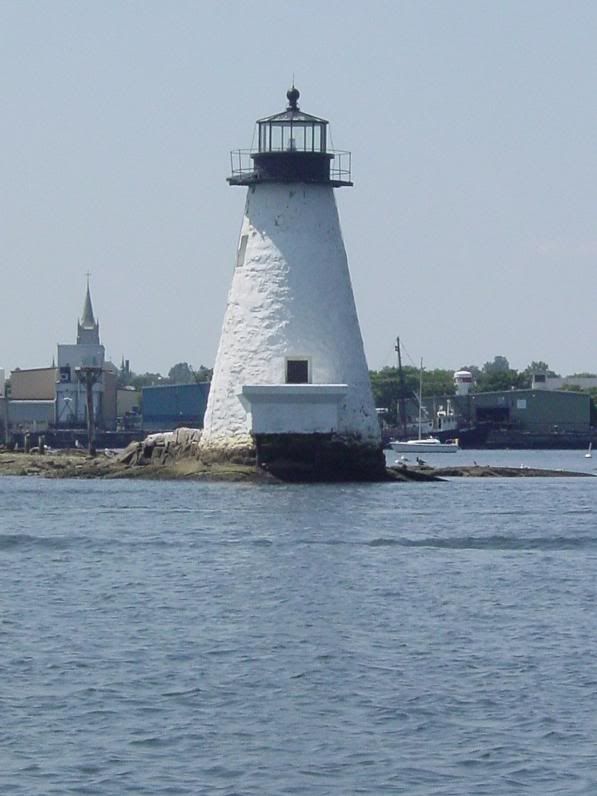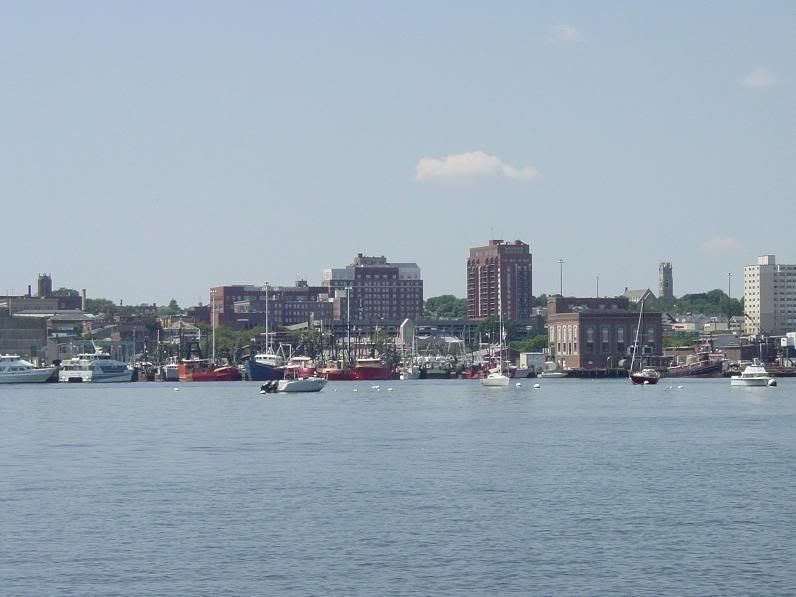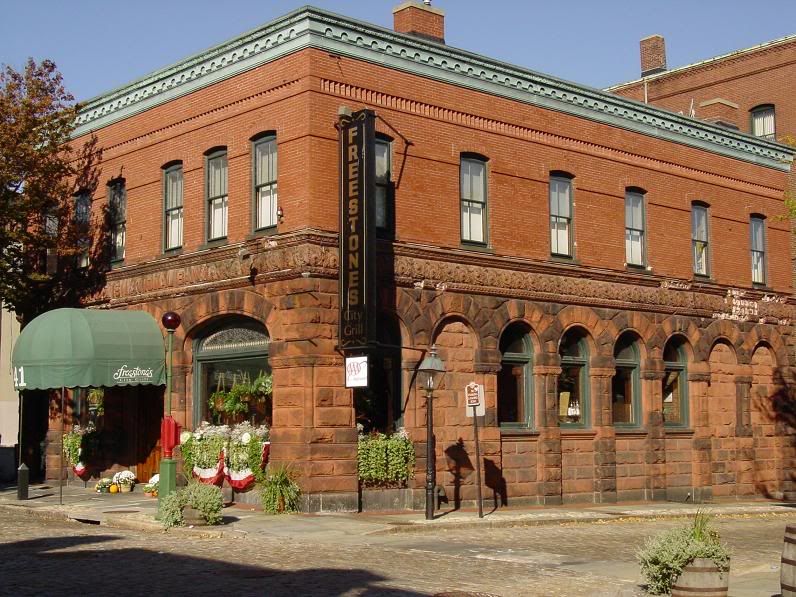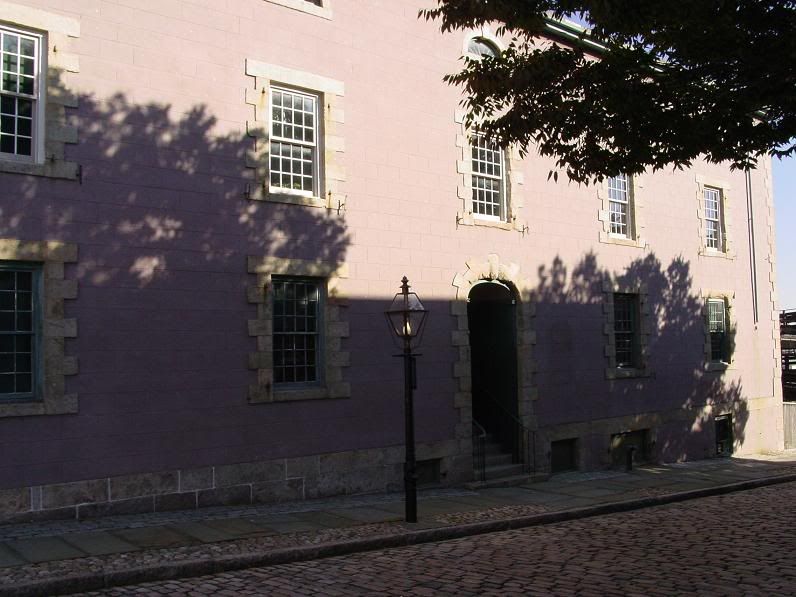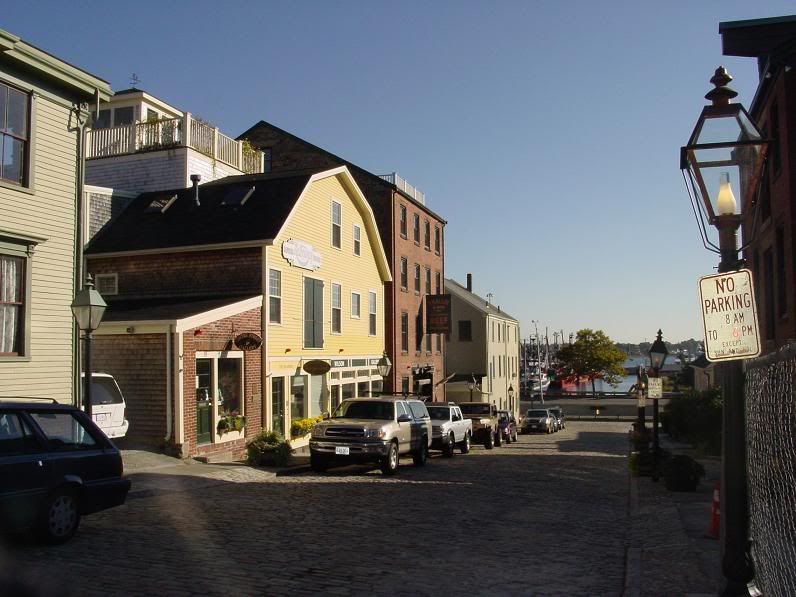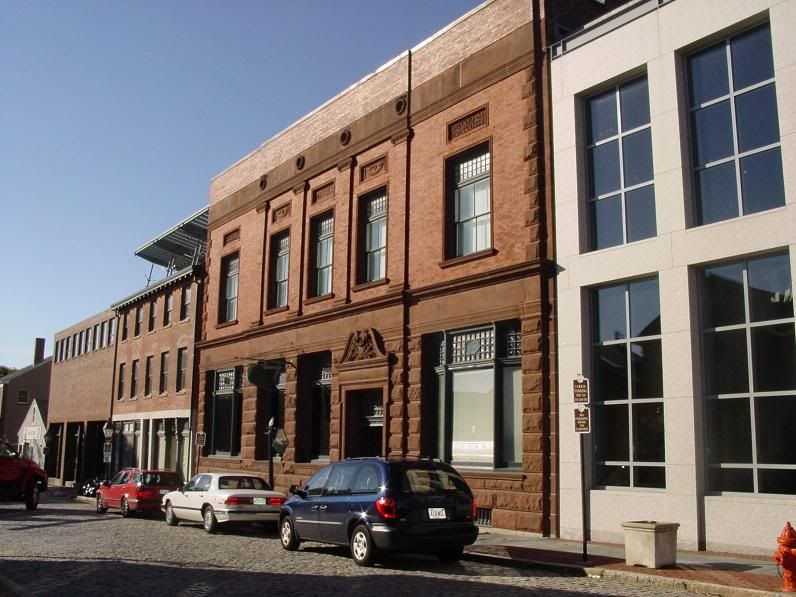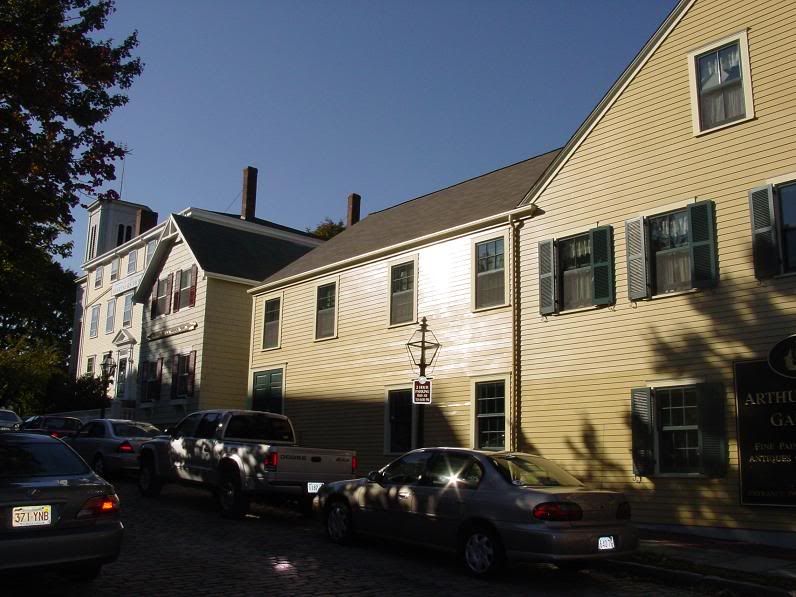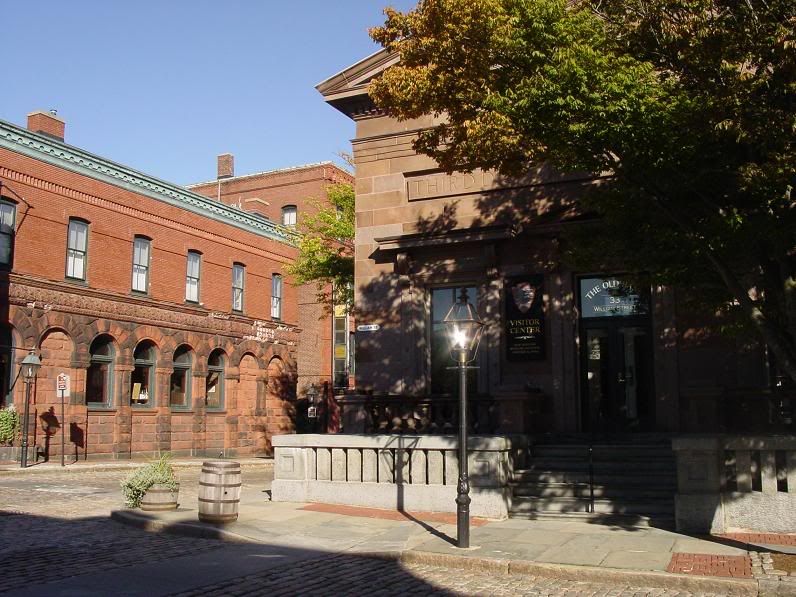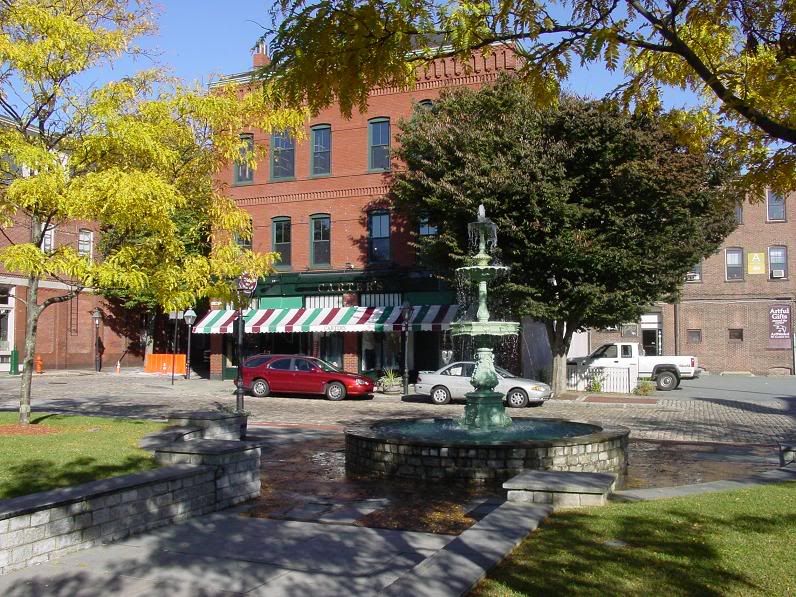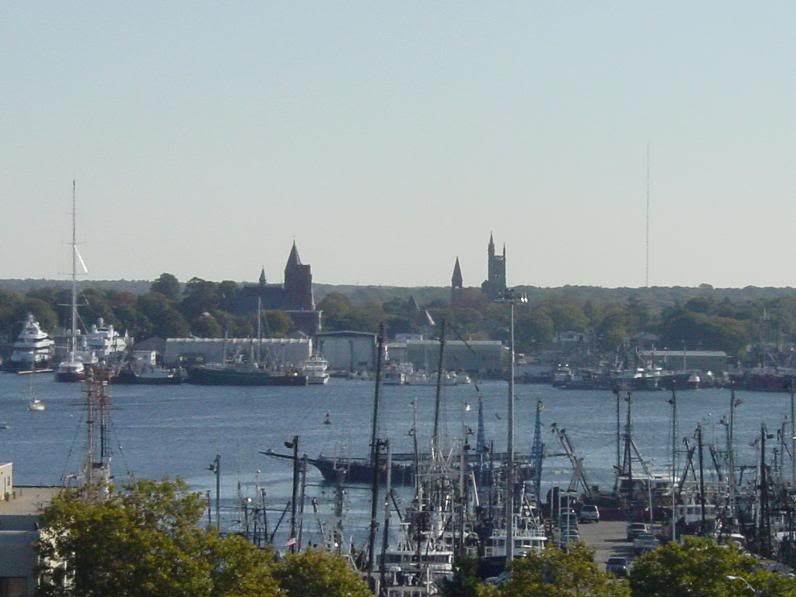Those are probably better places to compare it to, I am just almost completely unfamiliar with Gloucester and Newburyport so I didn't feel comfortable throwing those names out there and I almost said Salem, but again, I'm more familiar with Portland. If you combined Lowell and Salem, you'd have something similar to New Bedford in its current state.
You are using an out of date browser. It may not display this or other websites correctly.
You should upgrade or use an alternative browser.
You should upgrade or use an alternative browser.
New Bedford Developments
- Thread starter Lrfox
- Start date
Ron Newman
Senior Member
- Joined
- May 30, 2006
- Messages
- 8,395
- Reaction score
- 13
Gloucester is an active fishing port that also has a substantial tourist trade.
So it's not Hampton Inn after all, but Fairfield Inn is very similar.
It's funny that some of the comments on the Standard Times website about this are negative. People are complaining that this is the lowest Marriott Brand, which it is; but beggars can't be choosers. Since this will be the first hotel in the city, it's tough to argue for something nicer. If I'm in the hospitality industry I'm not going to build a 4 or 5 star hotel where not only is the market unpredictable, it just plain doesn't exist. You have to start somewhere, why don't people get that?
Also, the Cliftex Mill is being demolished this week to make room for another development (I'm not sure of what kind).
http://www.southcoasttoday.com/apps/pbcs.dll/article?AID=/20080314/NEWS/803140340/1011/TOWN10Waterfront hotel would be Fairfield Inn & Suites
By Joe Cohen
Standard-Times staff writer
March 14, 2008 6:00 AM
NEW BEDFORD ? The hotel planned for the city waterfront will be a four- to six-story Fairfield Inn & Suites by Marriott, according to the preliminary development plan.
Of the 106 rooms, 78 will be standard hotel rooms and 28 would be suites. Construction will begin by this summer and be completed by summer 2009, according to the plan, which is preliminary and subject to change.
While plans have not been finalized, Westport-based Lafrance Hospitality Co. is moving ahead aggressively with the multimillion-dollar project. The developer has hired architects and engineers and is committed to an aggressive development schedule.
Lafrance Hospitality hopes to lay out its detailed plans for the hotel before the City Council on March 27.
Richard L. Lafrance, who heads the firm that would build and operate the hotel, was not available for comment Thursday. He has indicated in the past he plans a "mid-scale" hotel with amenities including an indoor pool.
The Lafrance family has a long history on the SouthCoast, with properties that include White's of Westport and Hampton Inns in Fairhaven and Westport, as well as facilities in other states.
Lafrance Hospitality closed in late February on the purchase of the bulk of the land for the hotel, paying an estimated $1.5 million to $2 million. The land was owned by Scott Nanfelt and had until recently housed the Finicky Pet Food Co., which relocated further south on the waterfront. It had been assessed by the city for $1.3 million.
Lafrance hospitality needs the City Council's approval to purchase two small pieces of land adjacent to the Nanfelt property to round out its development.
The development site is bounded by MacArthur Drive to the west, Walnut Street to the north and Water Street Extension on its east side. The official address of the hotel would be 144 Water St., according to the preliminary plan.
Two relatively small pieces of land ? one at the northwest corner and the other at the easterly tip ? would be sold by the city to Lafrance Hospitality to complete the development parcel. An existing building on Walnut Street would be left intact, according to the plan.
City officials have said they are pleased with the Lafrance Hospitality plan.
The New Bedford Economic Development Council had conducted a hotel feasibility study of building a new hotel in downtown. While they had been convinced the concept was economically viable, they had prior to the study been unable to convince a developer to commit to the project.
However, after the study was done and the economic viability was established, developers expressed interest in a hotel.
City officials have said a new hotel can be a cornerstone for improving the city's business climate and would support the "creative economy" and promote New Bedford as a travel and tourism destination.
Earlier this month, Mayor Scott W. Lang, whose administration spearheaded the hotel development effort, said: "People come on day trips. Now they can come and stay, and help drive the restaurants, museums and the theater. A hotel complements all of that."
It's funny that some of the comments on the Standard Times website about this are negative. People are complaining that this is the lowest Marriott Brand, which it is; but beggars can't be choosers. Since this will be the first hotel in the city, it's tough to argue for something nicer. If I'm in the hospitality industry I'm not going to build a 4 or 5 star hotel where not only is the market unpredictable, it just plain doesn't exist. You have to start somewhere, why don't people get that?
Also, the Cliftex Mill is being demolished this week to make room for another development (I'm not sure of what kind).
Last edited:
Interesting article on Short Sea Shipping. This could potentially benefit more than just the South Coast, but since the focus of the article is a UMass Dartmouth Symposium and New Bedford and Fall River, I'll re-post it here. Some stimulus such as this one could be beneficial for coastal New England cities everywhere.
http://www.southcoasttoday.com/apps/pbcs.dll/article?AID=/20080331/NEWS/803310334/1011/TOWN10
Short Sea Shipping the Wave of the Future?
By Joe Cohen
Standard-Times staff writer
March 31, 2008 6:00 AM
DARTMOUTH ? A "perfect storm of opportunity" could drive the East Coast to embrace short sea shipping and put ports such as New Bedford and Fall River back on the map as significant players in moving cargo up and down the Atlantic seaboard.
Climate change and transportation issues, including the push to cut emissions and rising fuel prices, could combine with the re-emergence of cities as sought-after places to live, spinning up the "perfect storm of opportunity," according to Douglas I. Foy, former state secretary of Commonwealth Development.
Most Viewed Stories
Mr. Foy was speaking at a Short Sea Shipping Symposium last week at UMass Dartmouth.
Short sea shipping is a waterborne transportation system that does not cross an ocean. At the UMass conference, it was defined as freight moved in tractor-trailers carried long distances on water on specially made barges or ships. Short sea shipping advocates say it cuts costs, saves massive amounts of energy and dramatically reduces pollution. It has been widely used in Europe for years, and there is already some short sea shipping activity in the United States.
Mr. Foy has a longtime background in environmental advocacy and is a partner in Serrafix, a Boston company seeking to mitigate climate change and overhaul energy policy.
Richard S. Armstrong, executive secretary of the Massachusetts Governor's Seaport Advisory Council, said short sea shipping could be under way in New Bedford and Fall River within two years.
It could mean hundreds of jobs and many millions of dollars to the economy of a port city like New Bedford, officials said.
Mr. Armstrong said he has looked at 33 small East Coast ports as potential short sea shipping terminals and New Bedford and Fall River have outstanding characteristics.
Ideally, Mr. Armstrong said, a port in New England would be "paired" with another port, such as Port Canaveral in Florida.
In studying "port pairings," he looked at Port Canaveral and Wilmington, N.C., among others, and said there could be service between Florida and New England within two years.
Mr. Armstrong said the ports of New Bedford and Fall River have strong advantages, such as being small and flexible with infrastructure in place.
New Bedford Port Director Kristin Decas said the harbor has relatively low congestion and 30-foot depths. In addition to increasing use of the harbor and creating jobs, Ms. Decas said, short sea shipping through New Bedford would support industry in the region and put the area on the "front end" of supply chains for products.
She said a number of things would have to be done to prepare the harbor for short sea shipping, including involving the community, setting up a state-of-the-art terminal for roll-on, roll-off trailers and making certain other infrastructure was ready.
The UMass conference last week attracted about 60 attendees, including federal, state and local government officials, consultants, lawyers and environmental activists, along with a smattering of people from the shipping industry. Ports in Connecticut, Maine, Massachusetts and Rhode Island were represented.
Lt. Gov. Timothy Murray, who opened the symposium, said "cost effective and efficient transportation" is critical to economic competitiveness, and short sea shipping is an opportunity to "look at things differently" and to "get trucks off the road."
Rockford Weitz and Benjamin Mazzotta of the Fletcher Maritime Studies Program at Tufts University provided preliminary findings of their research on national security, environmental and economic benefits of short sea shipping.
Their findings indicate benefits would include increased productivity, reduced highway maintenance and congestion, cleaner air and safer highways.
Mr. Weitz and Mr. Mazzotta said they believe 20 smaller East Coast ports would lend themselves to short sea shipping and that the total investment in ports for a large-scale program would be $50 million, or no more than $5 million a port. They estimated it would take 200 sea-going vessels, including 177 barges. The cost of the vessels could run into the billions of dollars. They estimate that the short sea shipping business would create 13,000 jobs and at the scale of their estimates would remove 10 percent of the truck traffic from highways in the Northeast.
When congestion on highways gets bad enough, "entrepreneurs will arrive," they said.
Mr. Armstrong said he believes that if just 7 percent of north-to-south East Coast trailer truck traffic was shifted to short sea shipping, it would produce break-even operations.
Mr. Armstrong said that while short sea shipping barges travel 14 to 16 mph ? requiring four days to move from Florida to New England ? trucks average only 35 mph. That average is expected to drop to 27 mph as highway congestion intensifies, he said. And, because water travel is typically round-the-clock while truckers take extended breaks off the road, short sea shipping offers competitive timing for delivering freight, even for just-in-time shipments.
In the Tufts research, a short sea shipping program between Norfolk, Va., and Baltimore, using a single barge that carries 456 trailer-like containers was studied. That one barge carries the equivalent of 228 rail cars or 456 trucks. The estimated fuel use of the barge is one-eighth that of trucks.
Paul H. Bea Jr., formerly with the Port Authority of New York and New Jersey and now a public affairs consultant, said the federal government should provide funding for short sea shipping and suspend the Harbor Maintenance Tax that adds cost to short sea shipping and discourages its use.
Mr. Bea said the U.S. needs a "next generation" policy regarding transportation.
Mr. Foy said that when people learn about the advantages of short sea shipping, "It is an 'aha' moment."
Contact Joe Cohen at jcohen@s-t.com
http://www.southcoasttoday.com/apps/pbcs.dll/article?AID=/20080331/NEWS/803310334/1011/TOWN10
- Joined
- May 25, 2006
- Messages
- 7,033
- Reaction score
- 1,864
I glad SSS is catching on as an idea. Not too many people know about it but it would really help the east coast.
This is a presentation by the president of the Association for Public Transportation to the Lieutenant Governor's transportation conference in October 2007. Go to page 21 to see the info on SSS.
http://www.car-free.com/papers/Strategic_Transportation_Infrastructure.pdf
This is a presentation by the president of the Association for Public Transportation to the Lieutenant Governor's transportation conference in October 2007. Go to page 21 to see the info on SSS.
http://www.car-free.com/papers/Strategic_Transportation_Infrastructure.pdf
I had a couple dozen pictures on my cell but I must have deleted them, I apologize. I'll be down there April 6 & 13 for some sailing and I'll try to get into the city for a quick photo session. There's not a whole lot to be seen but I doubt many people have seen New Bedford at all.
I really hope this happens, and not just in New Bedford, but in many other coastal cities as well.
http://www.southcoasttoday.com/apps/pbcs.dll/article?AID=/20080410/OPINION/804100327/1011/TOWN10
http://www.southcoasttoday.com/apps/pbcs.dll/article?AID=/20080410/OPINION/804100327/1011/TOWN10
YOUR VIEW: Freight would complement city's fishing port
By KRISTIN DECAS
Ms. Decas is executive director of the New Bedford Harbor Development Commission.
April 10, 2008 6:00 AM
Congestion is on the verge of collapsing the truck network.
With East Coast interstate trade projected to triple in the next 10-15 years, the nation's highway systems simply cannot handle the expected exponential increase in truck traffic. The goals of clean air, open space, and quality of life are incompatible with further extensions and expansions of the highway system. Short sea shipping, through the reuse of a reinvigorated and robust coastal shipping network, the "ocean highways," promises a sound alternative for the future and a real opportunity for economic growth for the port of New Bedford.
In order to supplement the editorial of April 1, I feel it is important to submit additional facts about short sea shipping and explain how it will compliment, not compete with, the existing industries that are the bloodline of the New Bedford economy.
Short sea shipping will not use New Bedford's commercial fishing infrastructure. In fact, plans are in play to expand the public piers and wharves that support the city's No. 1-ranked fishing fleet. Likely hubs for short sea shipping include State Pier and Maritime Terminal, with backland staging areas for truck traffic.
Short sea shipping equals jobs, and new jobs. Less than 20 years ago, three stevedore companies provided over 50,000 man-hours of labor for oceangoing import/export activity. Since that time, the port has seen a decline of 75 percent in labor man-hours, identifying it as a vastly undertapped resource for economic growth and job creation. Short sea shipping offers a viable opportunity to rebuild this labor market by bringing freight activity to the port.
Further, as a short sea shipping hub, New Bedford moves to the front line of the supply chain, lowering the cost of transporting cargo and thereby attracting new business to the area and stimulating economic growth of existing backland industries. This means more jobs. A study funded by the governor's Seaport Council indicated short sea shipping could bring as many as 800 jobs to the region.
As for truckers, short sea shipping is a win, and national trucking associations and unions are on board. The current turnover rate for truckers is over 100 percent due to rising fuel costs, regulations on long-haul trips, and the unwillingness of drivers to be away from home for long periods. Many truckers are paid by the number of trips made, not by miles traveled. Short-haul moves would allow them to run multiple trips and increase their income. Other benefits include lower fuel consumption and improved lifestyle. No jobs are lost; rather, there will be a shift to short-haul trips from long-haul trips. Traffic issues can be addressed by scheduling vessels and truck transport for night hours and staging trucks in industrial areas.
Short sea shipping will only be a piece of the vibrant working waterfront. The commercial fishing industry is the soul of our economy and will only gain by the revitalization of the port. There are opportunities on many fronts, including global import/export trade, industrial water-borne industries, recreational boating, and cruise and ferry services. It is not one use vs. another, but how all these industries can work as a whole to compliment one another and best sustain the great city of New Bedford.
Ok, I'm double-posting, but I think it's necessary. The important part of this article (aside from the obvious support from the city) is that they're trying to work the historic building at this location into the design which of course likely means that this won't be the typical suburban looking mediocre chain hotel. It'll be unique looking, mediocre chain hotel; but hey, you have to start somewhere.
http://www.southcoasttoday.com/apps/pbcs.dll/article?AID=/20080411/NEWS/804110358/1011/TOWN10
I love that NB is getting a decent hotel, but if it's a "dream come true" someone needs to go back an look at their goals again.
*Edit* Aerial photo of the site:

and the adjacent Historical Bourne Counting House:

I'm not sure what the "whaling era building" is that they plan to incorporate into the new hotel, but I don't think this is it (this is a registered historic landmark). I'll get a photo of it as soon as I find out.
City Council rallies behind waterfront hotel plans
By Joe Cohen
Standard-Times staff writer
April 11, 2008 6:00 AM
NEW BEDFORD ? The City Council threw its support behind a downtown waterfront hotel proposed by the Lafrance family of Westport.
A majority of councilors openly expressed their excitement about the long-awaited project Thursday night. And a spokesman for the Lafrance family ? which has already spent about $2 million on the project ? pledged that the family would follow through on its promises.
Related Stories
The hotel is proposed for land between the JFK Memorial Highway and Leonard's Wharf.
As currently proposed, the hotel would be five stories, 106 rooms with 101 parking spaces. Hotel amenities would include meeting rooms, fitness area and an indoor pool with Jacuzzi.
The council Thursday night conducted a public hearing and approved a series of measures allowing the city to go ahead with closing and realigning some streets and selling two small parcels of land to Lafrance Hospitality Co. The changes in the roads are necessary to allow development of the site, and the two small parcels would be added to the main property to support parking and green areas. Roads involved include a portion of Water Street Extension, MacArthur Boulevard and the JFK Memorial Highway.
The site currently houses an old building that dates back to the whaling industry. More recently, Finicky Pet Food Co. operated from the site before relocating further south along the waterfront.
Lafrance Hospitality has indicated it wants to begin construction this summer and open the hotel by summer 2009.
James H. Libby of Newport Collaborative Architects said plans for the hotel are still being worked out, but his firm is trying to incorporate at least part of the old whale-oil processing building into the plan and wants to make the look of the hotel align with other buildings in what is a historic area on the working waterfront.
Mr. Libby said the design would be "sensitive to the context" of the area and, as new construction, it will "fit in" with surrounding buildings.
R. Christian Lafrance told the council it can count on his family following through on its commitment. "We have already made a big investment in the city ? the hotel will be there," Mr. Lafrance said.
Those and other remarks from the development team brought positive reaction from the council.
"You are making a dream come true," Councilor Denis Lawrence Jr. said. "Kudos."
"I have been excited about this since I (first) heard about it," Councilor Bruce Duarte Jr. said, noting its location in Ward 4, which he represents.
"This is an initial start for many major projects," Council David Alves predicted.
Councilor Brian Gomes said, "It is a piece of the puzzle ? it will bring other things to the city."
The hotel project is a major achievement for the administration of Mayor Scott W. Lang, which convinced Lafrance to invest in the project. The Lang administration used a detailed study of the city's hotel market to convince Lafrance the plan was viable.
Contact Joe Cohen at jcohen@s-t.com
http://www.southcoasttoday.com/apps/pbcs.dll/article?AID=/20080411/NEWS/804110358/1011/TOWN10
I love that NB is getting a decent hotel, but if it's a "dream come true" someone needs to go back an look at their goals again.
*Edit* Aerial photo of the site:

and the adjacent Historical Bourne Counting House:

I'm not sure what the "whaling era building" is that they plan to incorporate into the new hotel, but I don't think this is it (this is a registered historic landmark). I'll get a photo of it as soon as I find out.
Last edited:
Ok, two articles from the standard times today. The first involves the idea of listing the historic tax cap to spur development in historical buildings like New Bedford's Fairhaven Mills. The second is about Mayor Land pushing for air service from New Bedford's airport to Hub cities like New York and Philadelphia.
http://www.southcoasttoday.com/apps/pbcs.dll/article?AID=/20080416/OPINION/804160348/1011/TOWN10
Interesting idea, and I don't see why the cap should be kept. but I also don't see how lifting the cap is going to singlehandedly save these projects. I doubt the cap acts as a prohibiter for most developers; I think the economy has filled that role currently. But what the hell, lift the cap, it can't hurt.
This Next one is a brief bit about potential airport service:
http://www.southcoasttoday.com/apps/pbcs.dll/article?AID=/20080416/NEWS/804160325/1011/TOWN10
I'm as optimistic about New Bedford as anyone is, but this is pure fantasy. Until the city has a little more to offer, especially in this economic slump, no airline is going to offer service from New Bedford to a hub city. The best right now that I can see New Bedford getting is seasonal Cape Air service from an NYC area airport. This would see tourist use from the Tri-State vacationers, but I doubt a long-term, year round connection is viable right now.
Lift cap on historic tax credits
Economic viability will be the litmus test of mill reuse in New Bedford, Fall River and other cities around the state. The best way to spur redevelopment of those mills is through historic tax credits, but Massachusetts restricts the credits too tightly.
Though the state upped its annual cap on tax credits for historic rehabilitation from $10 million to $50 million in the past few years, the cap still pits SouthCoast mills against the wealth of historic buildings in Lowell, Boston and the rest of Massachusetts.
Limiting the credits, it might seem, is simple economics: The state can only afford so much. But a study commissioned by Grow Smart Rhode Island suggests that for every $1 million invested in that state's historic tax credit program, the economic activity ? mainly in temporary and permanent jobs and increased property-tax valuation ? totaled $5.35 million.
Here in Massachusetts, despite the cap, historic rehabilitation tax credits have begun to sculpt a new face for New Bedford. Witness the Bristol Building downtown (the one that houses the Green Bean cafe) and the Wamsutta Mill apartment project on the waterfront. Both received historic tax credits. Both are beacons of hope for the city, even if the Bristol Building didn't fill up as quickly as everyone hoped.
By lifting the cap, Massachusetts will speed the rate of mill redevelopment by making more projects economically viable.
Unfortunately, Rhode Island lawmakers have put their respected program in peril by voting last week to close it to new projects. The bill, approved by both legislative houses, cuts the reimbursement rate for projects already under way and calls for the state to borrow $280 million to keep the tax credits afloat.
In troubled economic times, it's easy to see how that could happen. After all, the economic activity the credits generate does not appear as a revenue line in the state budget. So when lawmakers see a big expenditure, the program gets targeted for cuts.
Maybe the Rhode Island tax credits have accomplished enough that the program can take a breather. Not so in Massachusetts.
Local backers of erasing the cap ? including New Bedford Mayor Scott W. Lang, Economic Development Council chief Matthew Morrissey, and state Rep. Michael Rodrigues, D-Westport ? say the expense is well worthwhile.
Developers get the credit only when a project is completed. During the time that a large project is under construction, the property often gets reassessed, boosting tax revenue to the municipality. In the Rhode Island study, 24 percent of the value of the tax credits was recouped before the credit was issued.
As Rep. Rodrigues points out, Massachusetts applications for the tax credits have never exceeded the $50 million cap, because the cap creates a perception among developers that they won't get what the program promises.
When developers shy away, it's a big problem because city leaders can't recruit businesses to fill suites that don't exist. Mr. Morrissey believes uncapping the credit would lead to the speculative renovation he needs to market New Bedford's mills to companies that will bring jobs here.
If Massachusetts wants to revitalize its old urban centers, the subsidy the tax credit represents is indispensable. Without it, developers will opt to build new buildings for less money and far fewer headaches. And those buildings may be far from the city center, in a place that forces employees to burn a lot of time, money and fuel driving to work.
If we leave the mills empty, eventually they will be demolished, taking with them a piece of New Bedford's character ? precisely the character that will drive our city's renaissance with a little guidance from public policy.
It's time to rebalance the mix of state tax credits toward one that will be a boon to small post-industrial cities like New Bedford.
http://www.southcoasttoday.com/apps/pbcs.dll/article?AID=/20080416/OPINION/804160348/1011/TOWN10
Interesting idea, and I don't see why the cap should be kept. but I also don't see how lifting the cap is going to singlehandedly save these projects. I doubt the cap acts as a prohibiter for most developers; I think the economy has filled that role currently. But what the hell, lift the cap, it can't hurt.
This Next one is a brief bit about potential airport service:
April 16, 2008 6:00 AM
City eyes air service to Northeast hub
NEW BEDFORD ? Mayor Scott W. Lang said Tuesday the city is pursuing regular commercial air service between New Bedford Regional Airport and a major hub such as New York, Newark, N.J., or Philadelphia.
He talked about a link between SouthCoast and a major airport during a meeting with members of the The Standard-Times editorial board Tuesday morning.
Current economic conditions are difficult, he said, and major air carriers have financial problems related to fuel costs, competition and other factors.
He said the regional airport might have to settle, in the near term, for service in twin-engine, turboprop aircraft with only nine passenger seats.
Those aircraft, similar to planes flown by Cape Air between New Bedford and the Islands, have lower operating costs in part because of less restrictive requirements on the airport by the Federal Aviation Administration.
The mayor did not offer a timetable for when such a service might begin.
http://www.southcoasttoday.com/apps/pbcs.dll/article?AID=/20080416/NEWS/804160325/1011/TOWN10
I'm as optimistic about New Bedford as anyone is, but this is pure fantasy. Until the city has a little more to offer, especially in this economic slump, no airline is going to offer service from New Bedford to a hub city. The best right now that I can see New Bedford getting is seasonal Cape Air service from an NYC area airport. This would see tourist use from the Tri-State vacationers, but I doubt a long-term, year round connection is viable right now.
I think removing the tax credit cap is a brilliant idea. If there is high priority in relocating a business it is low taxes. Taxes kill economic development and lower tax revenue in the long term. I think the Mayor is learning from the Irish politicians and businessmen his office has been courting lately. If there is a contemporary model of economic develpment it is the Celtic Tiger.
Moreover, the other day I was walking along the riverfront on the Fairhaven side and was wondering if preserving the old mills is worth it. Maybe New Bedford ahould push something more radical such as demolition of the Mills and building new buildings. The waterfront is a goldmine with the long term EPA clean-up and the possible commuter rail to NB.
Moreover, the other day I was walking along the riverfront on the Fairhaven side and was wondering if preserving the old mills is worth it. Maybe New Bedford ahould push something more radical such as demolition of the Mills and building new buildings. The waterfront is a goldmine with the long term EPA clean-up and the possible commuter rail to NB.
^I'd have to agree with you on the mills buildings. I'd say tear them down and build with more density down there, it's going to happen soon, so they might as well start in that direction. If not, maybe incorporate the old buildings in a larger, denser development with a combination of the existing buildings and the addition of newer, more modern construction. If done correctly, it could look nice.
The other site I'm amazed has been vacant for so long is the open lot on the North side of Union street between Purchase and Pleasant streets. It's prime real estate, and something is bound to go there sooner or later.
But this is my contribution from the Standard Times for today, an article pertaining to the rebuilding of the Corson Building, destroyed by fire in 1997. It's set to re-open May 16th with everyone's favorite drunk, Ted Kennedy, doing the ribbon cutting:
and some highlights of the reconstruction project:
Two Pictures, the first is from user: RaphaelMazor on flickr, and the second is the Standard Times interior staff Photo:


The other site I'm amazed has been vacant for so long is the open lot on the North side of Union street between Purchase and Pleasant streets. It's prime real estate, and something is bound to go there sooner or later.
But this is my contribution from the Standard Times for today, an article pertaining to the rebuilding of the Corson Building, destroyed by fire in 1997. It's set to re-open May 16th with everyone's favorite drunk, Ted Kennedy, doing the ribbon cutting:
By DON CUDDY
Standard Times staff writer
April 23, 2008 6:00 AM
NEW BEDFORD ? Ten years ago, a fire raged through the historic Corson Building, causing the roof to cave in and leaving little more than charred beams and shattered glass.
On the morning after the September 1997 blaze, the structure was a blackened shell in danger of collapse, its future anything but certain.
Most Viewed Stories
Yet, thanks to a sustained effort over the past decade, the William Street building will soon begin a new chapter in its long history, rising from the ashes to serve as an interpretive and educational space for the National Park Service.
Sen. Edward M. Kennedy, D-Mass., will be among the dignitaries on hand for the ribbon-cutting ceremony, set for 3 p.m. May 16.
"This project really started the day after the fire when the Waterfront Historic Area League put up the money to stabilize it so it wouldn't be condemned. If it was torn down, there would have been this gaping hole right in the middle of the historic district," said Celeste Bernardo, Whaling National Historical Park superintendent.
The long-awaited park had become a reality less than a year before the fire, opening in November 1996.
Originally two separate buildings, dating from 1875 and 1884 and both owned by Temple S. Corson, who made his money in coal and shipping, the building had many uses over the years. It last housed the Piva family's popular Moby Dick gift shop, which featured nautical specialties and bric-a-brac.
After the fire, the Pivas donated the building to WHALE, which, in April 2004, passed it along to the Park Service. The National Park had been looking for more public meeting space within the park's boundaries, and the restoration project began with the planning and design phase.
Construction has been under way for the past 18 months. It started with the erection of a structural steel frame within the building ? the massive beams arrived in the city on seven trailers and were hoisted into place with a 60-ton crane.
The original brick exterior now features historically accurate windows and reconstructed storefronts, one of which will be occupied once again by the Pivas' Moby Dick store.
Located next to the park's visitor center, the three-story building has a large exhibition space and a 55-seat theater on the ground floor. The featured displays include an illustration of the global reach of the New Bedford whaling industry. A map of the world, 14 feet wide, includes 50 of the ports most frequented by New Bedford whaling vessels, while a huge wall map depicts the city and its wharves as they appeared in 1876.
Considerable exhibition space is also devoted to the successful restoration of the city's historic district with illustrations of the many buildings that have been saved.
"It speaks to the vision preservationists have of what can be," Ms. Bernardo said, pointing as an example to a picture taken in the 1970s of a dilapidated Rodman Candleworks building, which now houses the popular Candleworks restaurant.
"If you saw that building, you would think that no one in their right mind would want to save it. But look at it now. People forget that, since the late '50s, New Bedford has been a leader nationally in historic preservation. We are one of the first national historic landmark districts in the country."
The second floor of the renovated building will be used for public and educational programming and the third floor to provide office space for park staff. Park officials say that the $6 million restoration project, wholly funded by the park service, should be celebrated by all city residents.
"We want the community to come," Jennifer Gonsalves, chief of visitor services, said. "We've had firemen coming by already for a peek and they can't believe the building. We want the local contractors to come to see the fruits of their labor. This is a real celebration."
Contact Don Cuddy at doncuddy@s-t.com
and some highlights of the reconstruction project:
http://www.southcoasttoday.com/apps/pbcs.dll/article?AID=/20080423/NEWS/804230345At a glance
The Corson Building in downtown New Bedford, devastated in a blaze 10 years ago, is back in business as a National Park Service educational space after a $6 million restoration project. It was originally two buildings, built in 1875 and 1884.
The new space will feature:
* A 55-seat theater
* A large exhibition space
* A 14-foot-wide map of the world that includes the 50 ports most frequented by New Bedford whaling vessels
* Displays on New Bedford history
* A return of the Moby Dick gift shop, which was housed in the building before the fire
* Space for educational programming and National Park Service offices
Two Pictures, the first is from user: RaphaelMazor on flickr, and the second is the Standard Times interior staff Photo:


Good to see the Corson building back in order. I have walked by there on my way to my watering hole and was wondering when it would open. North of the downtown historical district is prime property. Any open spaceis worth purchasing and developing in this area.
Apparently the city of New Bedford is going to slap some restrictions on outdoor dining. The plan calls for restaurants to require permits from the city to set up outdoor seating, requiring there to be at least 4 feet of passable sidewalk between the closest table and the road. If there are barriers or fences, they must be easily movable, as nothing on the street can be permanent. If a restaurant serves alcohol, barriers MUST be in place, separating the people on the streets from the patrons. No one can order just alcoholic drinks, they must have something else (not clear yet on whether you need a full meal, or if splitting bread or an appetizer will suffice). Each restaurant that sets up outdoor seating must have a full menu.
No word on what the cost of obtaining a permit is, but I'm hoping it's minimal. New Bedford wouldn't have much without its restaurants, and slapping restrictions on them is not a great way to attract more. I love dining outdoors and I would hate to see this go away because of some over-the-top ordinance. Bad move in my opinion, but depending on the price of permit, and the specifics of the regulations, it could end up being worse.
Standard Times Photo:

link to the article:
http://www.southcoasttoday.com/apps/pbcs.dll/article?AID=/20080425/NEWS/804250355/1011/TOWN10
No word on what the cost of obtaining a permit is, but I'm hoping it's minimal. New Bedford wouldn't have much without its restaurants, and slapping restrictions on them is not a great way to attract more. I love dining outdoors and I would hate to see this go away because of some over-the-top ordinance. Bad move in my opinion, but depending on the price of permit, and the specifics of the regulations, it could end up being worse.
Standard Times Photo:

link to the article:
http://www.southcoasttoday.com/apps/pbcs.dll/article?AID=/20080425/NEWS/804250355/1011/TOWN10


